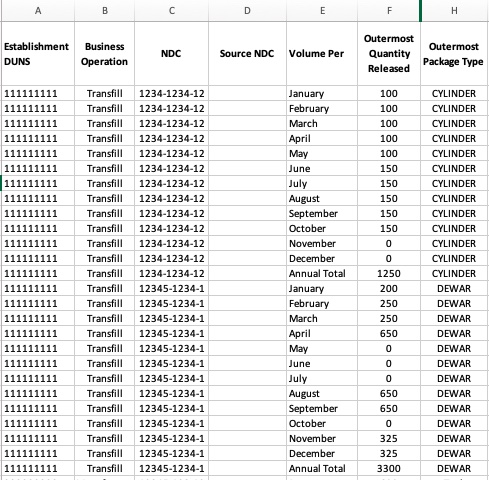By Tom Badstubner, Marilyn Dempsey, Michael Dodd, Rick Schweitzer and Steve Guglielmo
The GAWDA Consultant Program is a GAWDA member benefit that is included as part of your member dues to the association. It is consistently rated as one of the most valuable member benefits that GAWDA provides. Between the four of them, GAWDA’s consultants bring more than 100 years of industry-specific experience to the association.
In the first quarter issue, we spoke with the consultants about a variety of topics that will impact your business in 2022. From recently passed or upcoming legislation, to the continued impact of COVID, to an increased frequency of inspections. In this issue, we followed up on that discussion to see if those expected trends have come to pass and discuss what is on the horizon as we move into the second quarter of 2022.
Thank you to Tom Badstubner, GAWDA’s FDA and Medical Gases Consultant, Marilyn Dempsey, DHS, EPA and OSHA Consultant, Mike Dodd, DOT Consultant, and Rick Schweitzer, Government Affairs and Human Resources Consultant, for lending their time and expertise to discuss these important topics. The following is a lightly edited transcript of that conversation.
Welding & Gases Today: Since we spoke in November, there have been a slew of court cases that have been, if not finalized, at least hashed out to some extent. Rick, can you give us a state of affairs of where we stand with vaccine mandates?
Rick Schweitzer: There are two mandates that we’re particularly interested in. There’s the OSHA Temporary Standard, which required that large employers. Which required that large employers with 100 or more employees have to either have all of their employees vaccinated against COVID or submit to weekly testing before they come to work. The United States Supreme Court issued a stay of that mandate pending review of the merits of the case. The decision on the stay was a 6-3 decision. And the opinion said that OSHA did not have authority from Congress to issue what is, in effect, a public health mandate, rather than a workplace safety mandate, because it was simply too broad. That decision is binding on the lower courts and the case was sent back down to the court of appeals in Cincinnati for consideration of the merits. Subsequently, OSHA has withdrawn that emergency temporary standard, so that’s off the table, as a temporary matter.
However, there is more to the story. OSHA also, in that emergency temporary standard, used it as a proposed final rule and asked for public comments on the ETS as a proposed final rule. GAWDA joined in some comments with a number of other trade associations and submitted them to OSHA, as did many other affected businesses. OSHA is now pursuing a final rule that would implement some sort of vaccine mandate and testing mandate. Not on a temporary basis but on a permanent basis. Now, that raises the question, does OSHA have the authority to do that? And, based on the Supreme Court’s decision, I think the answer is no. I think that is fairly clear, actually, that OSHA can not do on a permanent basis what the Supreme Court said it couldn’t do on a temporary basis. However, it’s possible that OSHA is going to try to reconfigure the mandate and change it in some way that we don’t know yet how it would affect businesses and come out with something that might garner an additional two votes on the Supreme Court. So, we will have to see what comes out of OSHA from a final rule standpoint and then see how the courts handle that.
On the federal contractor mandate, this actually applies to all federal contractors and subcontractors. It was stayed by two different federal district courts and two separate federal courts of appeals have refused to dissolve that stay. So, the federal contractor mandate, right now, is stayed by the federal courts. That has not gone to the United States Supreme Court yet, it is still working its way through the various court systems. But, as it is right now, the federal contractor mandate, which only requires vaccination and does not have a testing option, is stayed for the time being.
WGT: In our last conversation, we also talked about some other regulations that have come up. Tom, we talked about the FDA and the monthly drug production and releases. Last time, we said that February 15th was the deadline for 2020 and May 16th was for 2021, and then subsequent years would be in February for the prior year. Are there any best practices our members should be aware of as we come up on these deadlines?

WGT: Mike, you’ve been warning GAWDA members that the DOT standards were going to change on February 7th. Now that they have, what does it mean for GAWDA members?
Mike Dodd: The main thing I want to do is remind people that this is for new, first-time CDL holders or those that want to upgrade from a B to an A for the first time. It’s not existing drivers. It will be for HAZMAT endorsements, for the first time, not renewals. So, for example. a question I received this week was, “If a driver has let his CDL expire, they were concerned that driver would have to go through the new entry-level driver training program.” And I said, no, because it’s only for first timers.
Rick: There is an FAQ on the DOT site that says that if your CDL has lapsed, you do not have to go through the training program, as long as it was issued before February 7th.
WGT: In the first quarter issue, across the board, you said that all of the tea leaves were saying that each agency would be stepping up their inspections and enforcement. Are you seeing that come to fruition so far? Is that something we’re still anticipating?
Marilyn Dempsey: I have seen inspections start to come through; including a targeted inspection, which is an unannounced inspection that is part of their special emphasis inspection program. They don’t give any notice of inspection, they just show up. I received a call from a member company that was chosen. The inspector came in, introduced himself and said he was going to inspect the facility. The company called me and asked, “What do we do?” We walked through the steps of the inspection, limits to the inspection, and how they are to be treated (never leave them alone!) They came to find out their company just happened to be on this targeted list and happened to be on the way to the inspector’s office. So, they were ripe, low-hanging fruit.
There have also been some state inspections that have been going on. However, I haven’t heard any big issues come out of them – it is just disruptive to your workday, even if you are prepared. The inspection is just less painful if you are prepared.
WGT: Tom, how about with the FDA? Have you seen inspections picking up?
Tom: Actually, we have not. We have seen a couple of state and federal inspections. Just a couple. It will start up. But we’re not seeing anything on the horizon.
Mike: I have not seen an uptick either.
Rick: No, not at all.
Tom: I did want to bring up something a little different. We are seeing, in the states, laws being passed to help control Medicare costs. This is being coordinated at a federal level. And the laws being passed at the state level are very similar. And they’re asking drug suppliers, like GAWDA members who fill medical oxygen, to submit what their wholesale costs are to the state. The idea is that the state wants to control the wholesale costs of drugs.
However, in every state so far, the regulations do not apply to medical gases. And so, I would encourage GAWDA members that if they get one of these letters from the State Board of Pharmacy or Board of Health where they are expected to register and report wholesale drug costs to review the request very carefully.
There are two reasons why medical gas suppliers are not normally covered. The first reason is that there are several ways that drugs can be authorized by Congress. There are separate sections of the United States code that authorize drugs.
And our section is section 360ddd. There are other sections besides that that cover biologics, injectables, and traditional pharmaceuticals. Our section of the U.S. Code is not typically mentioned in these new regulations, and that can be the reason we are excluded.
The second reason we may not be included in these new regulations is that the monthly wholesale cost of medical oxygen may be below the reporting threshold.
WGT: Mike you had mentioned there were some other areas of interest you wanted to cover for DOT, as well?
Mike: I wanted to talk about taking care of normal, day-to-day items, like record-keeping. I have got a suggested filing system. I’ve had it out there for two decades and it has worked very well for the members. Those that follow it usually do very well on their on-site inspections and even the remote inspections. If members need a copy of that suggested filing system, just reach out to me and I can send it to them. And I want to remind them to go through and clean out their records. Some people are pack-rats. They want to keep everything. And it actually clutters things up and makes it more difficult to find what they do need. And, during an audit, it makes them look very unorganized. And my filing system will have the required retention periods.
Probably the one thing that I have people hang onto with a little more discretion is the vehicle accident files that involve other people. If it’s just property damage, it’s not a big deal after three years to throw that stuff away. But if it involves another person, I always tell them to ask their insurance company what their statute of limitations are for bringing a vehicular personal injury lawsuit. A lot of people wait until the very last minute to bring a lawsuit up, so we want to make sure you haven’t thrown anything away that will help you. So, concentrate on record-keeping, use a good system, keep it clean and keep things for how long they’re supposed to be kept.
Marilyn: I agree with Mike’s comment, it’s important that you review your programs. And when you complete the review that you note the new revision/review date. This shows that you didn’t just write it back in 1972 and let it sit, collecting dust, but that you have been reviewing it on a regular basis, that it is up to date and accurate. For example, the Hazard Communication and Facility Emergency Action plan are two documents that require current information that may change from year to year.
I had another topic I wanted to discuss, as well – workforce challenges. There is a shortage of workforce employees, especially the younger generation. And they have different concerns. Not so much just, “am I going to get paid?” but they have some social justice and some more non-tangible things that they’re looking for. I think one of the ways that the GAWDA consultants can be of help in this area is that we can help you with those non-tangible things that you can give to them. We can give you suggestions. The Safety Committee has suggestions. Starting with upper management involvement. People like to see that their boss is involved and engaged. Safety training is another non-tangible benefit because it demonstrates that you have a caring heart. You care about the workforce. And also training for advancement, where people know that they can move up and not be pigeonholed in one job. Those three things will help maintain and cultivate a good workforce.
Mike: One more thing I wanted to talk about, is the clearinghouse. We’ve been under that program now for about two years. I think, by now, most people have figured out how to get registered and get their stuff in. The help desk at the clearinghouse has become very good. They help a lot of people with problems. But, I’m afraid that some people may be forgetting that they’re required to do at least an annual query on existing drivers. We just went through that last January. We got everybody, hopefully, through that first query. And now, here we are again, by the time this comes out it will actually be past due, but they’re required to do at least an annual inquiry on all existing drivers. Most people do that with a limited because it doesn’t require the driver having to get involved, although they can do a full, if they wish, but that gets every driver involved, if they do that. So, I would suggest that you take the easy route. And then, I wanted to remind members that any new hires that they have for drivers, they have to do a full query and they have to do that, in addition, just like they used to, the previous employer inquiries asking about those drug and alcohol issues. And they will need to do that for the rest of this year, because it’s January 6, 2023, that they can stop doing the previous employer inquiries and just rely on the clearinghouse. Because they will have three years worth of data by then. So, I just wanted to remind members to do their annual queries.
Rick: There is a final rule on the Driver Vision Standards that goes into effect March 22. It actually allows a driver who doesn’t meet either the distance acuity test, which is basically that you have to have 20/40 vision in each eye, corrected or uncorrected, and you have to meet the field of vision test for your peripheral vision. Right now, if you don’t meet both of those standards in both of your eyes, then you are disqualified medically, and you would have to go through a waiver process to be medically qualified to drive a commercial motor vehicle. FMCSA is now saying that if, in one of your eyes, you don’t meet either the distance vision or field of vision test or both, you can actually go through a process that doesn’t require you to get a waiver, which is an administrative burden, but you simply work with your optometrist or your ophthalmologist and they do an evaluation of you and they report that to your medical examiner and then the medical examiner makes the final decision on whether or not you’re medically qualified. And it will allow drivers to actually be medically qualified even though they don’t technically meet the vision standards in one of their two eyes. Drivers with monocular vision could be qualified to drive without having to go through the waiver process. And then, each time you go through your medical qualification, you go back to your optometrist or your ophthalmologist and repeat the process to make sure that you’re still meeting their standards. This goes into effect March 22, and it should help somewhat in getting additional qualified drivers out into vehicles.
Mike: One last thing I wanted to mention to wrap things up, I always want to remind people to keep doing the things that we need to be doing on an ongoing basis, such as making sure their training schedules are kept up. Most DOT things are every three years. Make sure those are being met. I want to remind members to look at their MCS150 and make sure they have updated that at least every two years. That’s an easy thing to forget. The HAZMAT registration will be coming up at the end of June, that’s a good thing to remind people about. And then, by the time you see this article in the magazine, it will be past due on your Unified Carrier Registration.
One last thing, this will come out just before the SMC. As always, we really encourage people to come by and see us at the Contact Booth. We love talking to members, seeing them face-to-face, renewing old friendships and meeting all the new members. I’ve got several people that I talk to tell me that they’re looking forward to the SMC because it’s going to be their first one. I made it a point that they should come by the Contact Booth Program to come and see us.
Tom: Last thing for me, the GAWDA Medical Gas SOP program is reissued every year based on the many member suggestions and improvements from the previous year. And this year, it was also reissued in January. If members have not received their new copy of the GAWDA Medical Gas SOP program with new forms and new guidance all in one PDF, customized for them, including their own logo, they should reach out to me.









